This was published 2 years ago
Beaumaris Zoo, Hobart: Inside Australia's infamous, abandoned ghost zoo
By Steve Madgwick
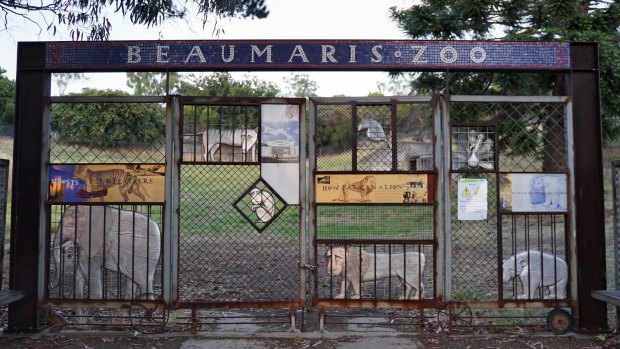
The metal sculptures entrapped on a gate that proclaims "Beaumaris Zoo" in retro mosaic could be obtusely provocative installations from Australia's mecca of shock-and-awe, MONA, only 10 kilometres away. Credit: Steve Madgwick
The mournful monkey with conquered eyes cannot even stand up in her torturously tiny cage. The dead-eyed lion fixates on the shiny padlock that secures the chain that strangles his liberty. The polar bear's cowered head defines defeat.
The metal sculptures entrapped on a gate that proclaims "Beaumaris Zoo" in retro mosaic could be obtusely provocative installations from Australia's mecca of shock-and-awe, MONA, only 10 kilometres away. They are not.
The provenance of that sinister looking gate that guards the fenced-off 2.2 hectares of Hobart's Queens Domain sharpens into focus only when your eyes land on the most unrecognisable of the downhearted creatures: the thylacine.
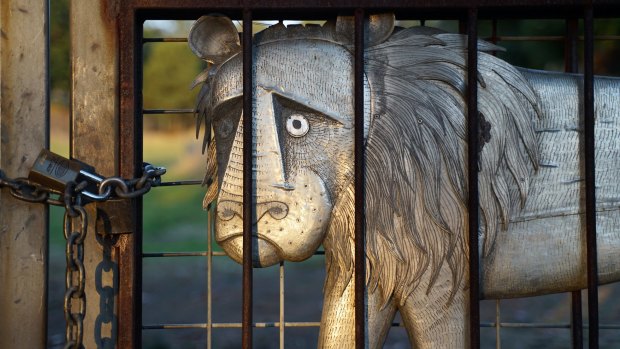
The dead-eyed lion fixates on the shiny padlock that secures the chain that strangles his liberty. Credit: Steve Madgwick
This was, is, that zoo – the place where the last Tasmanian Tiger met his maker. It's the location of that discomfit making black-and-white footage, where a catatonic thylacine goes through his last paces, conceivably aware that he is the last of his species.
A laminated-A4 sign warns visitors that beyond this mysterious portal is "a hazardous area" – it does not elaborate. An interpretive board intriguingly claims that Beaumaris hosts "the ghosts of fur and feathers". Given the notorious turning point in natural history that played out here, minds with an iota of curiosity are already scaling the fence.
"I find it interesting because there was no great story, nothing in the newspaper at the time, saying the 'last thylacine has died'," says Brendan Lennard, Hobart Council's senior cultural heritage officer for 25 years.
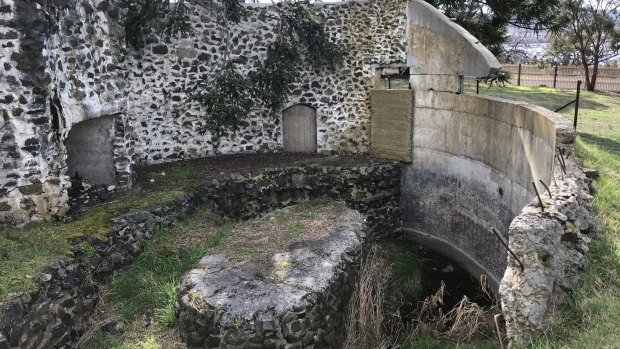
The ruins of the polar bear enclosure.Credit: Brendan Lennard
"It was only ever recorded in the council minutes. The idea was that the superintendent of parks would go and find another one. Even 20 years before, they definitely knew [thylacines] could become extinct, but they didn't know that this was the last one."
There are many stories about how "Benjamin" met his fate on September 7, 1936.
"One story is that the animal was locked out of its sleeping quarters; kept out in the open overnight. Whether that contributed – I don't like to speculate," says Brendan Lennard, who has recently retired.
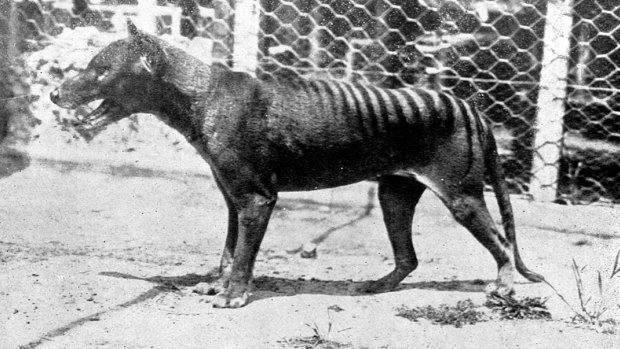
The last known Tasmanian Tiger, or Thylacine, died at the zoo in 1936.
The skeleton of Beaumaris is tantalisingly visible through the gate – itself an artwork installed in the 1990s for Threatened Species Day, which is still marked on the date of Benjamin's demise. The gulag-like leopard house and the oval, moated polar-bear enclosure still stand. The picket fence is original, as is the ladies "retiring room" and the now duckless duck pond.
Having conducted site tours for 20 years (and with plans to write a "retirement project" book), Brendan Lennard is Mr Beaumaris. Nowadays, he conducts 90-minute tours on special occasions or by demand (through Open House Hobart). He revels in re-animating the ghost zoo's glory days.
"You can make out where things were, show them photos of things like the bandstand, but it's a zoo where you really need an imagination."
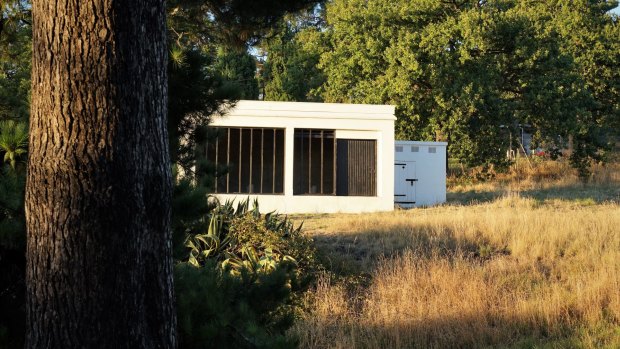
Some of the depressing enclosures are still standing.Credit: Steve Madgwick
Thousands flocked to Beaumaris when it opened in 1923. It was populated by a robust menagerie including lions, tigers and zebras, relocated from a private collection owned by a Mrs Mary Roberts, of Battery Point, after her death.
'If Melbourne and Sydney can have a zoo, why can't Hobart?' beamed proud locals. However, towards the end of the 1920s with the Great Depression looming, visitor numbers dwindled. In 1937, the Beaumaris Zoo itself suffered extinction, the year after Benjamin.
"The numbers never really justified the endeavour so they started selling off the main attractions. They sold off the elephant so they could get rid of the elephant keeper."
Beaumaris legends live vividly in Hobart folklore. The time a keeper lost an eye and eventually died after an altercation with an exotic bird thief. Then there's misadventures of the zoo's two Sumatran Sun Bears: one attacked an assistant keeper and the other was shot dead by police after scrambling up a tree.
The forgotten former convict quarry site became a naval fuel storage during World War II. Since the 1990s, it has remained an undeveloped green space; its use restricted by a law stating that the Queens Domain can only be used for educational and recreational purposes. There's an ironic twist to padlocking those gates closed.
"Beaumaris has indirectly become a refuge for some threatened birds and bandicoots. If it was open all the time, with people and dogs going in, it would be quite different," says Lennard.
Although history and cultural heritage are his bread-and-butter, Lennard doesn't shy away from the elephant in the zoo: the (mis)treatment of animals. While arguably zoos now champion species conservation over mere cruel spectacle, he questions whether humanity has learned any lessons from the Tasmanian Tiger's extinction – particularly with another eminent Taswegian, the devil, still toiling for survival.
"Growing up in the 1960s, we all thought that there's always going to be elephants and tigers, etc. But within our lifetime, because their habitats have been so impacted by human activity, you just can't take animals for granted anymore. It's a shocking indictment on what we've done in the past 60 years."
To some, Beaumaris is just an historical oddity. Others see just a pleasant green space outside Hobart's usual tourism suspects. Perhaps the ghost zoo has a more compelling role to play. While Threatened Species Day gets lost in a stampede of other causes baying for attention each year, Beaumaris Zoo stands resolutely as a sublime shrine to human consequences.
Stop by next time you wander north of Hobart's waterfront. Clear your mind and engage your imagination. Imagine what this place was and what it might be. Most importantly, reflect on what will never be again – and why.
Details
The zoo gates and interpretative signs are tucked away on Lower Domain Road (near the entrance to Government House) in the Queen's Domain, two kilometres north of Constitution Dock. For more information on tours by request and open days (such as on Threatened Species Day, September 7) contact Open House Hobart: email: tas@architecture.com.au phone: 03 6214 1500. See https://openhousehobart.org
See also: 'One of the worst places imaginable': Australia's very own lost city
Sign up for the Traveller Deals newsletter
Get exclusive travel deals delivered straight to your inbox. Sign up now.